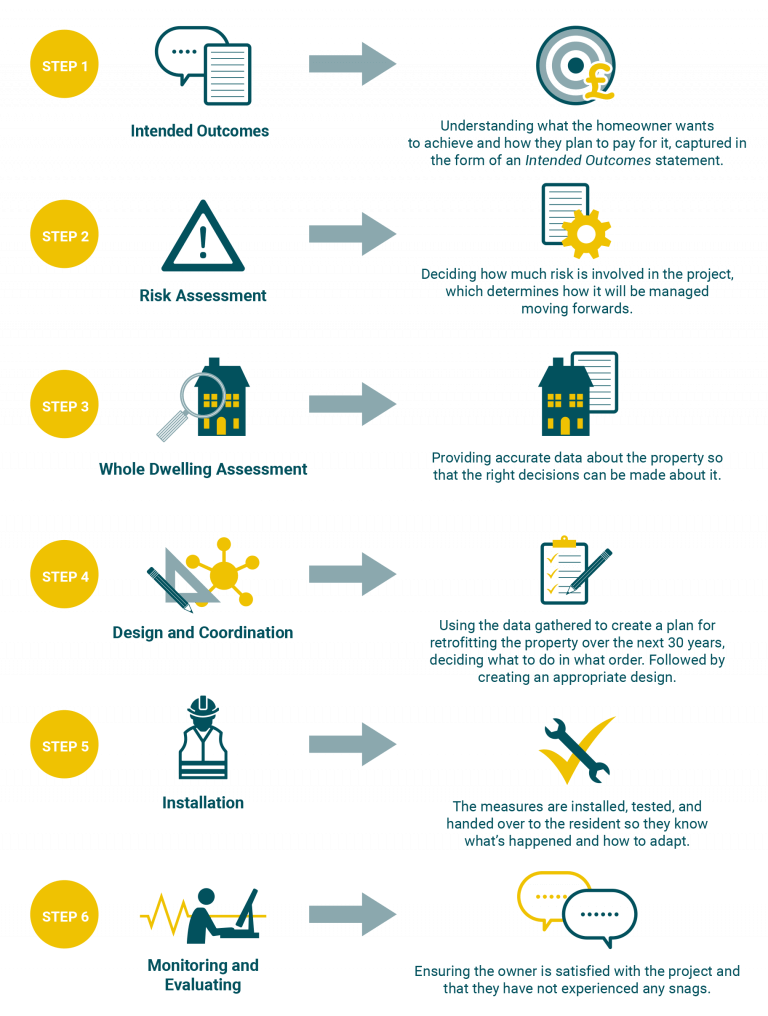The PRL Process
What is the scope of the retrofit process?
The scope of the process includes:
– Assessment of dwellings for retrofit.
– Identification and evaluation of improvement options as part of the design process.
– Monitoring and Evaluation of retrofit projects.
The measures and intent include:
– Improvements to the insulation of the elements of the building fabric and reducing thermal bridging.
– Improvements to building services.
– Improvements to the air-tightness of the building envelope.
– Establishing a safe dynamic moisture equilibrium through each element of the building fabric.
– Improving the resistance of the building envelope to water penetration.
– Providing metering and monitoring systems to promote the efficient use of energy.
– Advising building occupants about improvement options appropriate to their homes.
– Commissioning and handover of all of the above.
Taking a ‘fabric first’ approach
Whatever the scale of retrofit, a ‘fabric first’ approach is encouraged as the most cost effective and technically sound. The five stages to this approach are: 1) Bring the building fabric into good repair, by dealing with defects that inhibit energy efficiency and compromise improvement measures such as water penetration, damp, structural defects and poor pointing masonry 2) Implement “low hanging fruit” measures that are low cost and easy to install, e.g. energy efficiency lighting, basic heating controls, better control settings 3) Improve the building fabric by means of insulation and air-tightness measures, and by minimising thermal bridging, in order to reduce heat losses and demand 4) Satisfy the remaining heat demand as efficiently as possible using efficient heating technology and responsive controls 5) Use LZC “renewable” energy technologies to reduce emissions further.
The different PAS roles are all covered by PRL as part of the PRL Retrofit process:
Retrofit Advisor – PRL gives advice to a client or householder during the retrofit process, the evaluation of improvement options, the selection of improvement measures (EEM), the retrofit design, the operation and maintenance of installed measures, or how to operate a home in an energy efficient way after retrofit.
Retrofit Assessor: A PRL Retrofit Assessor has been trained to undertake a retrofit assessment for dwellings in accordance with PAS 2035. The activities completed within the retrofit assessment include the production of an RdSAP assessment, a detailed floor plan, a condition report and an occupancy assessment.
The data collected from these sources is used by the PRL Ltd. Retrofit Coordinator to formulate a Medium-Term Improvement Plan. The PRL Ltd. Retrofit Coordinator occupies a vital project management role within the retrofit process and is needed to protect both the interest of clients and the public. They are responsible for overseeing a domestic retrofit project from inception to completion, and will liaise with building owners, and other retrofit project stakeholders in order to ensure effective project management. A Retrofit Coordinator can prepare a Medium-Term Improvement Plan using data from retrofit assessments, to provide a scope for improvement over a 20-30 year period.
The PRL Retrofit Designer prepares a package of information that determines the unique combination of EEM systems, products, materials and their interrelationships, to be installed in a building in order to achieve specified energy efficiency and other outcomes for that building.
The PAS introduces a simple six-stage process that all retrofit projects must follow.

Ready to find out more?
Head over to the PRL Consultation Form for your Free Initial Consultation Enquiry...
